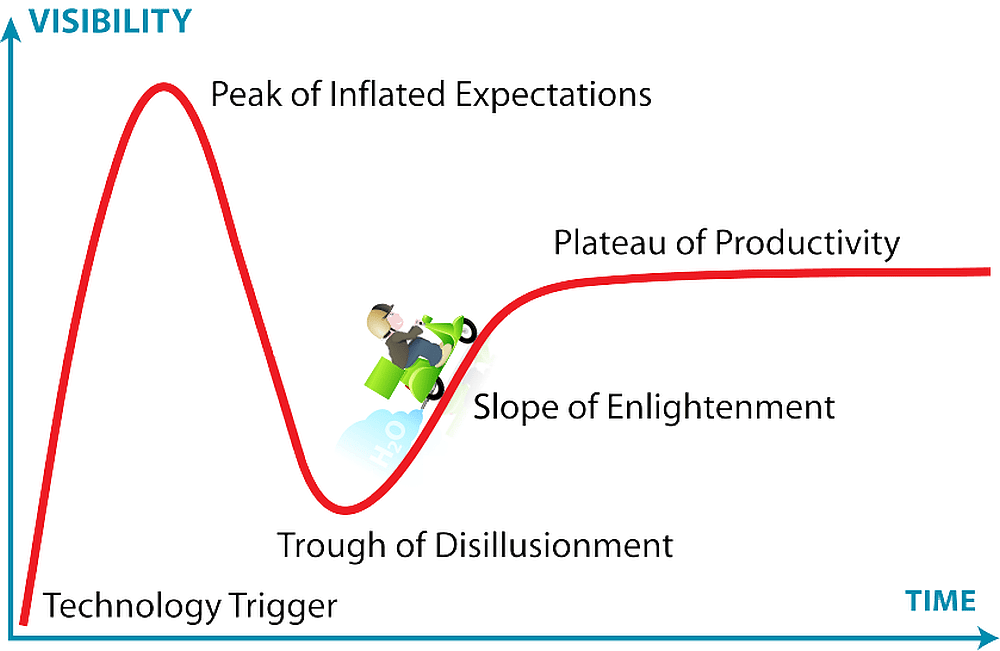
[Image above] Some power generation cooling towers are immense. Credit: Nick Smith/Wikipedia Commons/Creative Commons
Did you know that two-fifths of the freshwater uptake and 3 percent of actual freshwater consumption in the United States is by power generation facilities? I am not surprised the amount is big, but I didn’t know it was that big. So it should also come as no surprise that there is great interest in cutting these numbers.
Along these lines, the National Science Foundation, through its Directorate of Engineering, and the nonprofit Electric Power Research Institute (EPRI) are joining forces to seek ideas and support research and development of technologies for “advanced dry cooling for power plants,” and have issued a “Dear Colleague Letter” to kick off the three-year, $6 million initiative and find some disruptive solutions. From the letter:
“The “water-for-energy” issue is an important piece of the Energy-Water nexus. The goal of this collaboration is to leverage the complementary missions of applied research and commercialization (EPRI) and fundamental research and education (NSF) to foster enabling research and technology development that will lead to significant reductions or elimination of the use of water for cooling power plants. Through this joint collaboration, NSF and EPRI jointly solicit proposals with transformative ideas that meet the detailed requirements in this solicitation (NSF 13-564).
“In the U.S. power generation industry, steam-electric plants account for approximately 40% of the nation’s total freshwater withdrawals and approximately 3% of the nation’s total freshwater consumption. Power plants rely on condensers that use either once-through cooling, recirculating wet-cooling towers, or air-cooling to condense the steam discharge from the turbine. A potential approach toward eliminating or dramatically reducing water use in steam condensation is to use air-cooled steam condensers or to use hybrid technologies. Air-cooled condensers (ACC) used in practice typically have a steam-header feeding a large number of gravity driven finned-tubes for the condensate that drain into water pipes at the bottom. Large fans are used to circulate air past the finned-condenser tubes.
“Innovations in air-cooled condensers, hybrid-cooling and alternative dry cooling technologies are needed to reduce penalties, size and capital costs. These innovations must be accompanied by fundamental studies and improvements in our understanding. We seek innovative, “out of the box,” and game-changing, early-stage, dry-cooling ideas and concepts to dramatically reduce the steam condensation temperatures of the currently used air cooled condensers and develop more efficient, cost effective, and compact alternative dry cooling solutions for power plant steam condensation. Lead investigators must be from academic institutions in the US; industrial collaborations are encouraged. It is anticipated that $6 million total from the two agencies will be allocated for this three year effort, with individual awards anticipated to be in the $200,000-$700,000 range with an average award size of $300K/year. For additional details please refer to NSF 13-564. Proposals are due by 5 pm proposer’s local time on Aug. 19, 2013.”
This seems to be part of the Directorate’s Thermal Transport Processes program that aims to support
- Control of thermal transport processes in devices/systems and in materials processing for improved performance;
- Simulation and diagnostics of flow and heat transport bridging information across scales leading to device/system-level studies; and
- New materials/processes/devices with significant gains in thermal properties and performance.
This project sounds like it should be of great interest for those working in engineered ceramics and ceramic hybrid composites. NSF/EPRI also note that they are encouraging “collaborations between researchers that are doing fundamental research in ACC or hybrid cooling with those that focus on applied research and have appropriate facilities for testing successful ideas.”
I don’t know what the state-of-the-art is in regard to ceramics, but a multi-institutional group put together an interesting survey (pdf) in 2010 published in Applied Thermal Engineering titled “Ceramics and ceramic matrix composites for heat exchangers in advanced thermal systems—A review” by A. Sommers et al. (doi:10.1016/j.applthermaleng.2010.02.018). This review covered heat exchanging in general, not just water-based systems, so some of what they turned up didn’t apply.
Although the authors of this paper were able to collect the thermal and mechanical properties of individual ceramic materials and develop a rating system for comparing these materials to copper, aluminum and stainless steel, one of their interesting conclusions in the 2010 paper perhaps points to what NSF and EPRI are trying to get at:
“… thermal-hydraulic performance data are found to be limited. Heat exchanger designs are explored including the replacement of materials in existing designs and the use of these new materials with changes in heat exchanger configuration. Possible uses for ceramic materials in heat exchangers that hold substantial relevance and potential merit are discussed; however, many of these proposed applications have not been sufficiently studied to allow for a complete assessment of cost and benefit.”
I suspect there have been quite a few advances since 2010, so it will be interesting to see what proposals get submitted and accepted.
Author
Eileen De Guire
CTT Categories
- Basic Science
- Energy
- Market Insights
- Thermal management
Related Posts
Hype cycles: The uphill climb for hydrogen bikes
June 26, 2025


